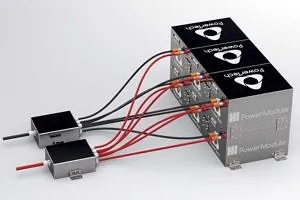Lithium Iron Phosphate (LFP or LiFePO4) :

Lithium Ferro Phosphate technology (also known as LFP or LiFePO4), which appeared in 1996, is replacing other battery technologies because of its technical advantages and very high level of safety.
Due to its high power density, this technology is used in medium-power traction applications (robotics, AGV, E-mobility, last mile delivery, etc.) or heavy-duty traction applications (marine traction, industrial vehicles, etc.)
Also, the long service life of the LFP and the possibility of deep cycling make it possible to use LiFePO4 in energy storage applications (stand-alone applications, Off-Grid systems, self-consumption with battery) or stationary storage in general.
To summarize, here is the major advantages list of Lithium Iron Phosphate technology:
- Very safe and secure technology
- Very low toxicity for environment (use of iron, graphite and phosphate)
- No use of rare earths and metals (Nickel, Cobalt, Manganese, etc.)
- Calendar life > 10 years
- Cycle life : from 3000 to several thousand (see chart below)
- Operational temperature range :up to 70°C
- Very low internal resistance. Stability or even decline over the cycles.
- Constant power throughout the discharge range
- Ease of recycling

Expected life-cycle of Lithium Iron Phosphate technology (LiFePO4)
Lithium Iron Phosphate technology is that which allows the greatest number of charge / discharge cycles. That is why this technology is mainly adopted in stationary energy storage systems (self-consumption, Off-Grid, UPS, etc.) for applications requiring long life.
The actual number of cycles that can be performed depends on several factors:
- LFP Standard or LFP SolidState technology
- Quality of Lithium Cell
- Level of power in C-Rate (1C rate means full discharge or charge in 1 hour, 0.5 C rate means full discharge or charge in 2 hour, 2C is the same but in half an hour)
- Depth of Discharge (DOD)
- Operational environment : temperature, humidity, etc.
The chart below shows the estimated number of cycles for our LFP Standard and LFP SolidState cells. The test conditions are those of a laboratory (constant temperature of 25 ° C, constant charge and discharge power ).

In standard environment, and for 1C cycles, we can get from the chart the below life cycle estimation for LFP :
- LFP Standard / LFP SolidState : 3000 / 4500 full cycles at 100% of DoD
- 4500 / 6500-8000 full cycles at 80% of DoD
- 12000 / 19000 fullcycles at 55% of DoD
- etc.
It should be noted that following the number of completed cycle, the batteries still have a nominal capacity > 80% of the original capacity.
















 France
France Europe
Europe Rest of the world
Rest of the world







